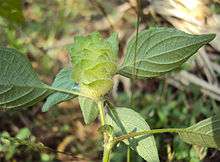Phaulopsis imbricata
Phaulopsis imbricata is a shrub native to South Africa.[2] It is also known as Himalayan ruellia. Leaves are opposite, one larger than the other in each pair, usually asymmetrical at the base.[3] Phaulopsis imbricata is a good fodder, the young leaves are eaten as a vegetable and the plant-ash in oil is rubbed into scarifications on the back for rheumatism in Tanganyika.[4] The flowers have an unpleasant smell.[5] It is filed as near-threatened by the IUCN.[1] It is one of the larval host plants of the butterflies great eggfly, tiny grass blue, brown pansy, soldier pansy and marbled elf.
| Phaulopsis imbricata | |
|---|---|
 | |
| Scientific classification | |
| Kingdom: | Plantae |
| Clade: | Tracheophytes |
| Clade: | Angiosperms |
| Clade: | Eudicots |
| Clade: | Asterids |
| Order: | Lamiales |
| Family: | Acanthaceae |
| Genus: | Phaulopsis |
| Species: | P. imbricata |
| Binomial name | |
| Phaulopsis imbricata (Forssk.) Sweet | |
| Synonyms | |
| |
References
- Ghogue, J.-P. (2010). "Phaulopsis imbricata". IUCN Red List of Threatened Species. 2010: e.T185412A8406478. doi:10.2305/IUCN.UK.2010-3.RLTS.T185412A8406478.en. Retrieved 15 January 2020.
- "CJB - African plant database - Detail".
- "Phaulopsis dorsiflora - Himalayan Ruellia".
- http://plants.jstor.org/upwta/1_72
- "Phaulopsis dorsiflora (Retz.) Santapau - Encyclopedia of Life".
External links

| Wikispecies has information related to Phaulopsis imbricata |
- Where seen
- Photos
- Dressler, S.; Schmidt, M. & Zizka, G. (2014). "Phaulopsis imbricata". African plants – a Photo Guide. Frankfurt/Main: Forschungsinstitut Senckenberg.
This article is issued from Wikipedia. The text is licensed under Creative Commons - Attribution - Sharealike. Additional terms may apply for the media files.
